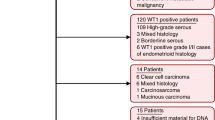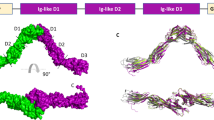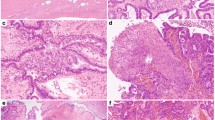Abstract
Epithelial ovarian cancer (EOC), the leading cause of death from gynecological malignancy, is a poorly understood disease. The typically advanced presentation of EOC with loco-regional dissemination in the peritoneal cavity and the rare incidence of visceral metastases are hallmarks of the disease. These features relate to the biology of the disease, which is a principal determinant of outcome1,2. EOC arises as a result of genetic alterations sustained by the ovarian surface epithelium (OSE; ref. 3). The causes of these changes are unknown but are manifest by activation of oncogenes and inactivation of tumor-suppressor genes (TSGs). Our analysis of loss of heterozygosity at 11q25 identified OPCML (also called OBCAM), a member of the IgLON family of immunoglobulin (Ig) domain–containing glycosylphosphatidylinositol (GPI)-anchored cell adhesion molecules, as a candidate TSG in EOC. OPCML is frequently somatically inactivated in EOC by allele loss and by CpG island methylation. OPCML has functional characteristics consistent with TSG properties both in vitro and in vivo. A somatic missense mutation from an individual with EOC shows clear evidence of loss of function. These findings suggest that OPCML is an excellent candidate for the 11q25 ovarian cancer TSG. This is the first description to our knowledge of the involvement of the IgLON family in cancer.
This is a preview of subscription content, access via your institution
Access options
Subscribe to this journal
Receive 12 print issues and online access
$209.00 per year
only $17.42 per issue
Buy this article
- Purchase on Springer Link
- Instant access to full article PDF
Prices may be subject to local taxes which are calculated during checkout






Similar content being viewed by others
Accession codes
References
Chi, D.S. et al. Identification of prognostic factors in advanced epithelial ovarian carcinoma. Gynecol. Oncol. 82, 532–537 (2001).
Hoskins, W.J. Prospective on ovarian cancer: why prevent? J. Cell. Biochem. Suppl. 23, 189–199 (1995).
Auersperg, N., Wong, A.S., Choi, K.C., Kang, S.K. & Leung, P.C. Ovarian surface epithelium: biology, endocrinology, and pathology. Endocr. Rev. 22, 255–288 (2001).
Thiagalingam, S. et al. Loss of heterozygosity as a predictor to map tumor suppressor genes in cancer: molecular basis of its occurrence. Curr. Opin. Oncol. 14, 65–72 (2002).
Davis, M., Hitchcock, A., Foulkes, W.D. & Campbell, I.G. Refinement of two chromosome 11q regions of loss of heterozygosity in ovarian cancer. Cancer Res. 56, 741–744 (1996).
Gabra, H. et al. Definition and refinement of a region of loss of heterozygosity at 11q23.3–q24.3 in epithelial ovarian cancer associated with poor prognosis. Cancer Res. 56, 950–954 (1996).
Gabra, H. et al. Chromosome 11 allele imbalance and clinicopathological correlates in ovarian tumours. Br. J. Cancer 72, 367–375 (1995).
Foulkes, W.D., Campbell, I.G., Stamp, G.W. & Trowsdale, J. Loss of heterozygosity and amplification on chromosome 11q in human ovarian cancer. Br. J. Cancer 67, 268–273 (1993).
Launonen, V. et al. Chromosome 11q22.3–q25 LOH in ovarian cancer: association with a more aggressive disease course and involved subregions. Gynecol. Oncol. 71, 299–304 (1998).
Jones, P.A. & Laird, P.W. Cancer epigenetics comes of age. Nat. Genet. 21, 163–167 (1999).
Shark, K.B. & Lee, N.M. Cloning, sequencing and localization to chromosome 11 of a cDNA encoding a human opioid-binding cell adhesion molecule (OBCAM). Gene 155, 213–217 (1995).
Harpaz, Y. & Chothia, C. Many of the immunoglobulin superfamily domains in cell adhesion molecules and surface receptors belong to a new structural set which is close to that containing variable domains. J. Mol. Biol. 238, 528–539 (1994).
Wilson, D.J., Kim, D.S., Clarke, G.A., Marshall-Clarke, S. & Moss, D.J. A family of glycoproteins (GP55), which inhibit neurite outgrowth, are members of the Ig superfamily and are related to OBCAM, neurotrimin, LAMP and CEPU-1. J. Cell Sci. 109, 3129–3138 (1996).
Gil, O.D., Zanazzi, G., Struyk, A.F. & Salzer, J.L. Neurotrimin mediates bifunctional effects on neurite outgrowth via homophilic and heterophilic interactions. J. Neurosci. 18, 9312–9325 (1998).
Funatsu, N. et al. Characterization of a novel rat brain glycosylphosphatidylinositol-anchored protein (Kilon), a member of the IgLON cell adhesion molecule family. J. Biol. Chem. 274, 8224–8230 (1999).
Hachisuka, A., Nakajima, O., Yamazaki, T. & Sawada, J. Developmental expression of opioid-binding cell adhesion molecule (OBCAM) in rat brain. Brain Res. Dev. Brain Res. 122, 183–191 (2000).
Lodge, A.P., Howard, M.R., McNamee, C.J. & Moss, D.J. Co-localisation, heterophilic interactions and regulated expression of IgLON family proteins in the chick nervous system. Brain Res. Mol. Brain Res. 82, 84–94 (2000).
Miyata, S. et al. Expression of the IgLON cell adhesion molecules Kilon and OBCAM in hypothalamic magnocellular neurons. J. Comp. Neurol. 424, 74–85 (2000).
Rai, S.K. et al. Candidate tumor suppressor HYAL2 is a glycosylphosphatidylinositol (GPI)-anchored cell-surface receptor for jaagsiekte sheep retrovirus, the envelope protein of which mediates oncogenic transformation. Proc. Natl. Acad. Sci. USA 98, 4443–4448 (2001).
Ji, L. et al. Expression of several genes in the human chromosome 3p21.3 homozygous deletion region by an adenovirus vector results in tumor suppressor activities in vitro and in vivo. Cancer Res. 62, 2715–2720 (2002).
Haber, D. & Harlow, E. Tumour-suppressor genes: evolving definitions in the genomic age. Nat. Genet. 16, 320–322 (1997).
Ponder, B.A. Cancer genetics. Nature 411, 336–341 (2001).
Balmain, A. Cancer: new-age tumour suppressors. Nature 417, 235–237 (2002).
Li, Q.L. et al. Causal relationship between the loss of RUNX3 expression and gastric cancer. Cell 109, 113–124 (2002).
Sellar, G.C. et al. BARX2 induces cadherin 6 expression and is a functional suppressor of ovarian cancer progression. Cancer Res. 61, 6977–6981 (2001).
Axton, R.A. et al. Combined SSCP/heteroduplex analysis in the screening for PAX6 mutations. Mol. Cell. Probes 11, 287–292 (1997).
Thompson, J.D., Higgins, D.G. & Gibson, T.J. CLUSTAL W: improving the sensitivity of progressive multiple sequence alignment through sequence weighting, position-specific gap penalties and weight matrix choice. Nucleic Acids Res. 22, 4673–4680 (1994).
Altschul, S.F. et al. Gapped BLAST and PSI-BLAST: a new generation of protein database search programs. Nucleic Acids Res. 25, 3389–3402 (1997).
Freigang, J. et al. The crystal structure of the ligand binding module of axonin-1/TAG-1 suggests a zipper mechanism for neural cell adhesion. Cell 101, 425–433 (2000).
Bates, P.A., Kelley, L.A., MacCallum, R.M. & Sternberg, M.J. Enhancement of protein modeling by human intervention in applying the automatic programs 3D-JIGSAW and 3D-PSSM. Proteins 45 Suppl. 5, 39–46 (2001).
Acknowledgements
The authors thank D. Porteous and S. Kerr for use of their facilities, S. Langdon for ovarian tumor RNAs and S. Bader for cell line DNAs. K.P.W. was funded by Scottish Hospitals Endowment Research Trust and University of Edinburgh Faculty of Medicine Fellowships. L.L. was funded by a Chinese Government Fellowship.
Author information
Authors and Affiliations
Corresponding authors
Ethics declarations
Competing interests
The authors declare no competing financial interests.
Supplementary information
Rights and permissions
About this article
Cite this article
Sellar, G., Watt, K., Rabiasz, G. et al. OPCML at 11q25 is epigenetically inactivated and has tumor-suppressor function in epithelial ovarian cancer. Nat Genet 34, 337–343 (2003). https://doi.org/10.1038/ng1183
Received:
Accepted:
Published:
Issue Date:
DOI: https://doi.org/10.1038/ng1183
This article is cited by
-
Emerging roles for the GPI-anchored tumor suppressor OPCML in cancers
Cancer Gene Therapy (2021)
-
Expression and promoter methylation status of OPCML and its functions in the inhibition of cell proliferation, migration, and invasion in breast cancer
Breast Cancer (2021)
-
Serum cell-free DNA methylation of OPCML and HOXD9 as a biomarker that may aid in differential diagnosis between cholangiocarcinoma and other biliary diseases
Clinical Epigenetics (2019)
-
Inactivating mutations and X-ray crystal structure of the tumor suppressor OPCML reveal cancer-associated functions
Nature Communications (2019)
-
OPCML is hypermethylated in a subset of patients with metaplastic changes in their esophagus
Biomarker Research (2018)



